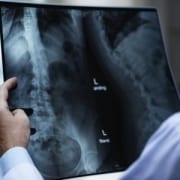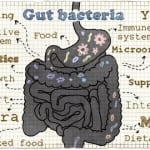"What Gluten Does" An Excerpt from Total Recovery
The following is the third in a series of excerpts on gut health from Dr. Gary Kaplan’s book “Total Recovery: A Revolutionary New Approach to Breaking the Cycle of Pain and Depression.”
“Leaky gut has been implicated in the growing number of food and environmental sensitivities affecting almost 25 percent of American adults. These are not food allergies, but delayed hypersensitivity reactions.1
As many as 40 percent of Americans are sensitive to gluten. One in 100 of those has a severe reaction in the form of an autoimmune disease, celiac disease.2
“Imagine gluten ingestion on a spectrum,” says Dr. Allesio Fasano, head of research at the University of Maryland Celiac Research Center. “At one end, you have people with celiac disease, who cannot tolerate one crumb of gluten in their diet. At the other end, you have the lucky people who can eat pizza, beer, pasta, and cookies – and have no ill effects whatsoever. In the middle, there is this murky area of gluten reactions, including gluten sensitivity or intolerance. This is where we are looking for answers.”3
Most doctors don’t know the difference. Some are unaware that gluten sensitivity can genuinely contribute to hundreds of diseases and that the symptoms may not manifest in the gut, but in other parts of the body.4
Years ago, we believed that celiac disease was a rare childhood syndrome. Today the average age of diagnosis is in individuals between ages 40 and 60. Celiac disease affects more than 2 million Americans – 1 in 133 people.5 Researchers have already confirmed that the dramatic rise in figures is not due to greater awareness. By testing old blood samples, they have shown that, in the last 50 years, the rate of celiac disease has increased fourfold.
Gluten intolerance is now estimated to affect 6 to 9 percent of the American population. Furthermore, people in their seventies, who have eaten gluten without problems their entire lives, are now experiencing gluten sensitivity.6
Unfortunately, gluten intolerance is sometimes viewed with skepticism. When the tests come back negative for celiac disease, many doctors dismiss their patients’ complaints rather than investigating further. Part of the problem is that, like allergy tests, gluten intolerance tests are not consistently reliable. While gluten intolerance is not an allergy to gluten, we have not yet found a definitive means of identifying it in the blood.
The only absolute way to determine gluten intolerance is to completely remove gluten from the diet for 6 weeks and see if the symptoms improve. It can be hard to tell. If there are other food intolerances and nutritional deficiencies at play, removing gluten may only eliminate some of the symptoms.
Peter Green, MD, director of the Celiac Disease Center, estimates that research into gluten intolerance is about 30 years behind celiac research.7 Without better research, patients are too often told it’s “all in their heads.” With a burgeoning series of product lines of gluten-free foods, estimated at $2.6 billion in sales last year alone, it is easy to assume that gluten intolerance is nothing more than a fad.8
It’s widely known that agricultural changes in wheat production over the past decades have altered wheat significantly and raised both its protein and gluten content.9 Some ascribe gluten sensitivity to the increase in our consumption of wheat. Gluten can now be found in everything from bread and canned goods to hand lotion and makeup.10 But the evidence is inconsistent. And the cause may lie in the bacteria in the gut itself. We’re beginning to suspect that gut bacteria determine whether the immune system treats gluten as food or as a deadly invader.11
In his studies of celiac disease, Dr. Fasano made an important discovery. He studied 47 newborns who were genetically at-risk for developing celiac disease. By the time they were 2 years old, these children had a fairly impoverished and unstable community of intestinal bacteria.12 As he continued to monitor their bacterial levels, the levels of lactobacilli declined in two children.
Both developed autoimmune diseases. One got celiac disease, and the other type 1 diabetes (which has a genetic proclivity similar to that of celiac disease).13
Dr. Fasano and his colleagues were excited. “Imagine what would be the unbelievable consequences of this finding,” he said. “Keep the lactobacilli high enough in the guts of these kids, and you prevent autoimmunity.”14
The questions is, was it the chicken or the egg? Which came first, the imbalance of bacteria or the autoimmune disease? Some studies show that intestinal inflammation accommodates bacteria that keep the inflammation going.15 As we’ve already observed, bacteria learn and fight hard to survive.
It’s a living system, where different choices can be made at any stage. Our genetics help determine our bacteria, but the bacteria can change us – turning genes off and on, adapting as they go. According to Bana Jabri, director of research at the University of Chicago Celiac Disease Center, even if the chicken comes first, the egg can contribute. “You have the same endpoint,” she says, “but how you get there may be variable.” Such complexity both confounds notions of one-way causality and suggests different paths to the same disease.16″
1 Lipski, Digestive Wellness
2 A. Fasano, “Zonulin and Its Regulation of Intestinal Barrier Function: The Biological Door to Inflammation, Autoimmunity, and Cancer,” Physiological Review 91, no. 1 (January 2011): 151–75, www.ncbi.nlm.nih.gov/pubmed/21248165.
3 Ibid.
4 Ibid.
5 A. Fasano et al., “Prevalence of Celiac Disease in At-Risk and Not-At-Risk Groups in the United States,” Archives of Internal Medicine 163, no. 3 (February 20, 2003): 286–92, www.ncbi.nlm.nih.gov/pubmed/12578508.
6 Melinda Beck, “Clues to Gluten Sensitivity,” Wall Street Journal, March 15, 2011, http://online.wsj.com/news/articles/SB10001424052748704893604576200393522456636.
7 Ibid.
8 Ibid.
9 Ibid.
10 Moises Velasquez-Manoff, “Who Has the Guts for Gluten?” New York Times, February 23, 2013, www.nytimes.com/2013/02/24/opinion/sunday/what-really-causesceliac-disease.html.
11 Ibid.
12 Ibid.
13 Ibid.
14 Ibid.
15 Ibid.
16 Ibid.
Reprinted from Total Recovery: A Revolutionary New Approach to Breaking the Cycle of Pain and Depression by Gary Kaplan, D.O., with permission from Rodale Books. Copyright (c) 2014 by Gary Kaplan, D.O..









Leave a Reply
Want to join the discussion?Feel free to contribute!